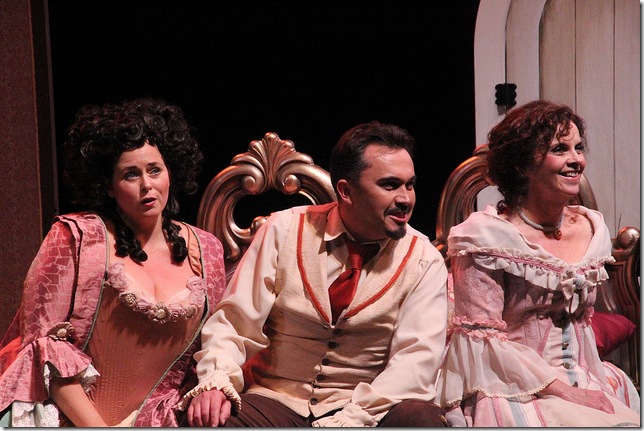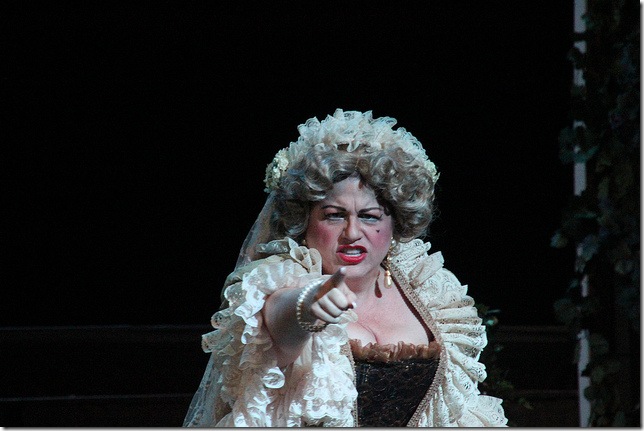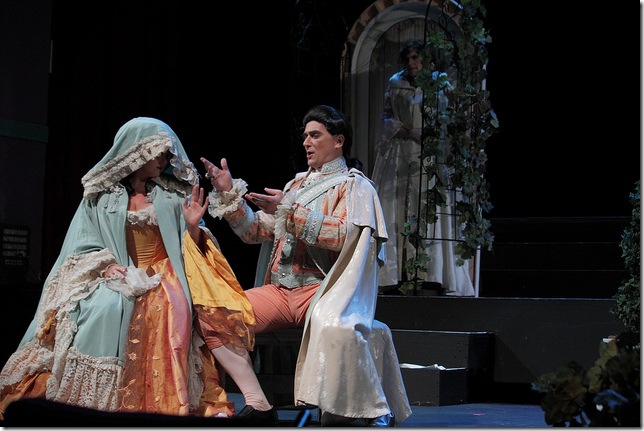The Orlando Philharmonic’s production Nov. 9 of Mozart’s Le Nozze di Figaro straddled a fine line that divides semi-staged from fully staged performances. These semi-staged productions of the Philharmonic either leave one feeling unsettled, as in this Figaro, or completely satisfied, as with last spring’s Rigoletto.
It is a dilemma directors must wrestle with continually: Go all-out to fully stage a semi- staged production (as here), or just let singers stand to face the audience, concert style.
Fenlon Lamb, making her debut, sited the orchestra too far to the rear of the stage to accommodate large set pieces, sending their sound up instead of out, thus widening the chasm between orchestra and singers, who must sing with their backs to the conductor. If this series ever moves to the new Arts Center in Orlando, I believe the orchestra must return to the pit for opera performances. (England’s Glyndebourne Opera uses two great London orchestras, The Royal Philharmonic and The Philharmonia, in the pit during their opera season.)
Orlando was very well-served by the excellent orchestra the night I heard them. Conductor Joel Revzen put together a marvelous cast accompanying the recitatives on the harpsichord. From the moment Robert Gierlach began to sing his first act aria, Se vuol ballare, we knew we had a caring and sweet voiced Figaro, a delicately placed baritone with rich colors.
Marian Pop, a Romanian baritone, was a masterful Count Almaviva, whose stentorian tones filled the house. His wife, Countess Almaviva, sung by Twyla Robinson, rushed her delivery of Porgi amor; there was no sense that she’d lost her husband’s love. But in her conniving letter aria with her maid, Susanna, the two voices blended exquisitely to make it a high point of the evening.
Susanna was sung beautifully by soprano Maureen O’Flynn. Her last aria, Deh vieni non tardar, was pure magic as she sang about the expectations of love and marriage. Cherubino, page to the Count, a pants role sung by a woman, was excellent in the shape of Stephanie Foley Davis.
Mezzo Susan Nicely, as Marcellina, nearly succeeded in stealing the show with her brilliant performance of the frustrated overbearing duenna, anxious to marry Figaro. She was one of the best Marcellinas I’ve seen in a long time.
Tenor Jason Ferranti was called upon to sing two roles, that of Don Basilio, the gossip-loving music master, and Don Curzio, the lawyer, both sung with panache and in perfect character. Peter Strummer’s Doctor Bartolo had his moment early on in Act I with the aria, La vendetta, which was good. Andrew Gray’s performance of the gardener, Antonio, was over the top, but I liked his bass baritone voice very much; it’s a refreshing, vibrant, energetic voice.
Soprano Alexandra Hale was a pleasing Barbarina and will go on to more coloratura roles with her very lovely voice, I’m sure. A good debut for her. Chorus Master Robin Stamper prepared a very fine group who sang on key and were above the ordinary for a regional opera chorus.
But there remains the problem of the venue’s appropriateness. Operas in the 18th century were played in small houses of less than 800 seats. Perhaps the Bob Carr Center, with 2,500 seats, was not the ideal for this intimate Mozart gem.
The Orlando Philharmonic’s next operatic production is Puccini’s Madama Butterfly on April 5 and 7 next year with Robert Swedberg, who was for many years head of the Orlando Opera, directing.


